The state transition testing market is estimated to be valued at USD 1.3 billion in 2025. As per Future Market Insights, a top research partner for Fortune 1000 companies, the market is projected to reach USD 3.4 billion by 2035, registering a compound annual growth rate (CAGR) of 10.5% over the forecast period.
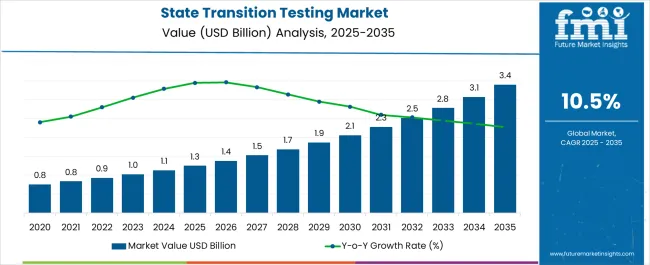
| Metric | Value |
|---|---|
| State Transition Testing Market Estimated Value in (2025 E) | USD 1.3 billion |
| State Transition Testing Market Forecast Value in (2035 F) | USD 3.4 billion |
| Forecast CAGR (2025 to 2035) | 10.5% |
The State Transition Testing market is being driven by the growing need for improved software reliability, especially in complex systems where state-dependent behavior must be validated to ensure performance and safety. The current market scenario reflects a strong preference for automated testing methods, which have gained prominence as organizations move toward faster development cycles and continuous integration pipelines.
Increased digitization in sectors such as banking, financial services, and insurance has further accelerated the adoption of state transition testing, as these industries require robust validation processes to maintain operational stability and regulatory compliance. The ability to simulate multiple states and transitions through automation has reduced testing time and enhanced fault detection.
With the rapid expansion of software-based services and increasing investment in test automation tools, the market is expected to continue growing steadily As software complexity rises, and companies prioritize efficiency and quality, state transition testing is being positioned as a critical component of the software development lifecycle, with future opportunities expected in cloud-based testing solutions and AI-supported test generation.
The state transition testing market is segmented by type, application, and geographic regions. By type, state transition testing market is divided into Automated Testing and Manual Testing. In terms of application, state transition testing market is classified into Banking, Financial Services, And Insurance (BFSI), Information Technology (IT) And Telecommunications, Retail And E-Commerce, Healthcare, Government And Public Sector, Energy And Utilities, and Manufacturing. Regionally, the state transition testing industry is classified into North America, Latin America, Western Europe, Eastern Europe, Balkan & Baltic Countries, Russia & Belarus, Central Asia, East Asia, South Asia & Pacific, and the Middle East & Africa.
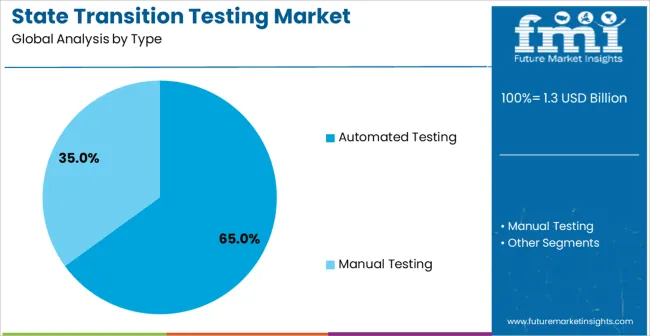
The Automated Testing segment is estimated to hold 65.00% of the State Transition Testing market revenue share in 2025, making it the largest segment in terms of testing type. The prominence of this segment has been driven by its ability to enhance testing efficiency and accuracy across software applications that require validation of multiple states and transitions. Automation is increasingly being used to address the complexities associated with state-dependent processes, reducing the need for manual intervention while improving fault coverage.
The rising demand for faster time-to-market and cost-effective validation has accelerated its adoption across enterprises. The segment’s growth has been supported by the integration of automated test scripts with continuous integration and delivery pipelines, enabling early fault detection.
Furthermore, automated testing tools have been integrated with advanced frameworks that allow parameterization and reuse of test cases, which enhances their scalability and applicability As enterprises seek to optimize testing efforts while improving software quality, automated testing is expected to maintain its leadership position in the market.
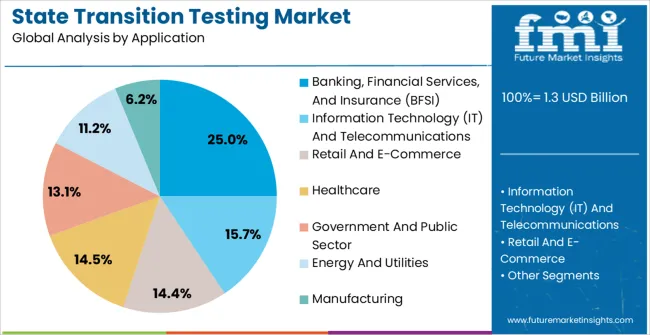
The Banking, Financial Services, and Insurance segment is projected to account for 25.00% of the State Transition Testing market revenue share in 2025, making it a key application area. This segment’s prominence has been driven by the critical need for robust software validation in systems that process sensitive financial transactions and customer data.
The complexity of state-dependent operations, such as transaction workflows, risk management, and fraud detection, has necessitated the adoption of state transition testing to ensure accuracy and resilience. Increasing regulatory requirements related to data security, operational transparency, and compliance have further accelerated the use of automated testing tools in this sector.
Additionally, the growing reliance on digital banking platforms, mobile payment systems, and insurance claim processing has increased the scope for testing state transitions, which are often at the core of these applications With the need for uninterrupted service and fault-free operations, the banking, financial services, and insurance sector is expected to continue investing in state transition testing as a core strategy to enhance software reliability and meet customer expectations.
The state transition testing is defined as the technique of testing the changes in input conditions which may cause state changes in the application under test. State transition testing is a black box testing technique where the behavior of an application under test is analyzed by the tester for different input conditions in a sequence.
In the state transition testing technique, tester which analysed the conditions provides both the positive as well as negative input test values and record the same. Here, the finite system gets a different output for the same input, depending upon conditions happened before.
Furthermore, the state transition testing is the model on which the system along with tests are based. State transition testing technique is widely used and are helpful where you need to test different system transitions.
State transition testing are majorly used when a tester is analyzing or testing the application for a finite set of input values, trying to test the sequence of events occurring in the application under test, when the system has the dependency on the values or events in the past. Furthermore, states, transitions, events, and actions are the four main components of the state transition model.
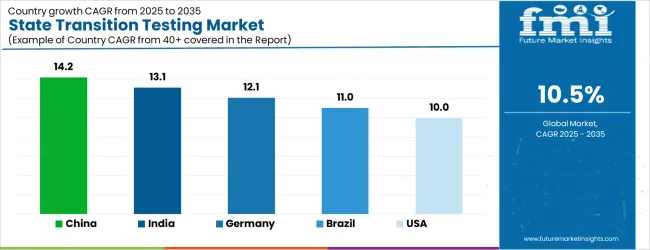
| Country | CAGR |
|---|---|
| China | 14.2% |
| India | 13.1% |
| Germany | 12.1% |
| Brazil | 11.0% |
| USA | 10.0% |
| UK | 8.9% |
| Japan | 7.9% |
The State Transition Testing Market is expected to register a CAGR of 10.5% during the forecast period, exhibiting varied country level momentum. China leads with the highest CAGR of 14.2%, followed by India at 13.1%. Developed markets such as Germany, France, and the UK continue to expand steadily, while the USA is likely to grow at consistent rates. Japan posts the lowest CAGR at 7.9%, yet still underscores a broadly positive trajectory for the global State Transition Testing Market. In 2024, Germany held a dominant revenue in the Western Europe market and is expected to grow with a CAGR of 12.1%. The USA State Transition Testing Market is estimated to be valued at USD 437.5 million in 2025 and is anticipated to reach a valuation of USD 437.5 million by 2035. Sales are projected to rise at a CAGR of 0.0% over the forecast period between 2025 and 2035. While Japan and South Korea markets are estimated to be valued at USD 64.6 million and USD 40.1 million respectively in 2025.
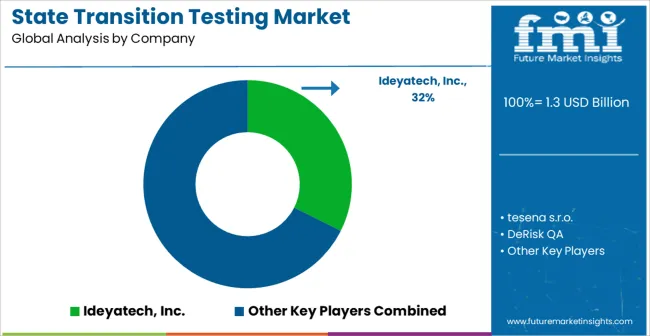
| Item | Value |
|---|---|
| Quantitative Units | USD 1.3 Billion |
| Type | Automated Testing and Manual Testing |
| Application | Banking, Financial Services, And Insurance (BFSI), Information Technology (IT) And Telecommunications, Retail And E-Commerce, Healthcare, Government And Public Sector, Energy And Utilities, and Manufacturing |
| Regions Covered | North America, Europe, Asia-Pacific, Latin America, Middle East & Africa |
| Country Covered | United States, Canada, Germany, France, United Kingdom, China, Japan, India, Brazil, South Africa |
| Key Companies Profiled | Ideyatech, Inc., tesena s.r.o., DeRisk QA, Sparx Systems Pty Ltd., Prezi Inc., Intertek Group plc, Stratfor Enterprises, LLC, and RiseSmart, Inc. |
The global state transition testing market is estimated to be valued at USD 1.3 billion in 2025.
The market size for the state transition testing market is projected to reach USD 3.4 billion by 2035.
The state transition testing market is expected to grow at a 10.5% CAGR between 2025 and 2035.
The key product types in state transition testing market are automated testing and manual testing.
In terms of application, banking, financial services, and insurance (bfsi) segment to command 25.0% share in the state transition testing market in 2025.






Our Research Products

The "Full Research Suite" delivers actionable market intel, deep dives on markets or technologies, so clients act faster, cut risk, and unlock growth.

The Leaderboard benchmarks and ranks top vendors, classifying them as Established Leaders, Leading Challengers, or Disruptors & Challengers.

Locates where complements amplify value and substitutes erode it, forecasting net impact by horizon

We deliver granular, decision-grade intel: market sizing, 5-year forecasts, pricing, adoption, usage, revenue, and operational KPIs—plus competitor tracking, regulation, and value chains—across 60 countries broadly.

Spot the shifts before they hit your P&L. We track inflection points, adoption curves, pricing moves, and ecosystem plays to show where demand is heading, why it is changing, and what to do next across high-growth markets and disruptive tech

Real-time reads of user behavior. We track shifting priorities, perceptions of today’s and next-gen services, and provider experience, then pace how fast tech moves from trial to adoption, blending buyer, consumer, and channel inputs with social signals (#WhySwitch, #UX).

Partner with our analyst team to build a custom report designed around your business priorities. From analysing market trends to assessing competitors or crafting bespoke datasets, we tailor insights to your needs.
Supplier Intelligence
Discovery & Profiling
Capacity & Footprint
Performance & Risk
Compliance & Governance
Commercial Readiness
Who Supplies Whom
Scorecards & Shortlists
Playbooks & Docs
Category Intelligence
Definition & Scope
Demand & Use Cases
Cost Drivers
Market Structure
Supply Chain Map
Trade & Policy
Operating Norms
Deliverables
Buyer Intelligence
Account Basics
Spend & Scope
Procurement Model
Vendor Requirements
Terms & Policies
Entry Strategy
Pain Points & Triggers
Outputs
Pricing Analysis
Benchmarks
Trends
Should-Cost
Indexation
Landed Cost
Commercial Terms
Deliverables
Brand Analysis
Positioning & Value Prop
Share & Presence
Customer Evidence
Go-to-Market
Digital & Reputation
Compliance & Trust
KPIs & Gaps
Outputs
Full Research Suite comprises of:
Market outlook & trends analysis
Interviews & case studies
Strategic recommendations
Vendor profiles & capabilities analysis
5-year forecasts
8 regions and 60+ country-level data splits
Market segment data splits
12 months of continuous data updates
DELIVERED AS:
PDF EXCEL ONLINE
Prostate-Specific Antigen Testing Market Analysis - Size, Share & Forecast 2025 to 2035
United States Preclinical Medical Device Testing Services Market Trends – Growth, Demand & Analysis 2025-2035
Testing, Inspection & Certification Market Growth – Trends & Forecast 2025 to 2035
5G Testing Market Size and Share Forecast Outlook 2025 to 2035
AB Testing Software Market Size and Share Forecast Outlook 2025 to 2035
2D Transition Metal Carbides Nitrides Market Size and Share Forecast Outlook 2025 to 2035
Prostate Cancer Market Growth - Trends & Forecast 2025 to 2035
5G Testing Equipment Market Analysis - Size, Growth, and Forecast 2025 to 2035
Prostate Health Market Trends - Growth, Demand & Forecast 2025 to 2035
Eye Testing Equipment Market Size and Share Forecast Outlook 2025 to 2035
HSV Testing Market Size and Share Forecast Outlook 2025 to 2035
IoT Testing Equipment Market Size and Share Forecast Outlook 2025 to 2035
HPV Testing and Pap Test Market Size and Share Forecast Outlook 2025 to 2035
GMO Testing Services Market Insights – Food Safety & Regulatory Compliance 2024 to 2034
GMP Testing Services Market
LTE Testing Equipment Market Growth – Trends & Forecast 2019-2027
Drug Testing Systems Market Size and Share Forecast Outlook 2025 to 2035
Open Transition Transfer Switch Market Size and Share Forecast Outlook 2025 to 2035
Sand Testing Equipments Market Size and Share Forecast Outlook 2025 to 2035
Tire Testing Machine Market Size and Share Forecast Outlook 2025 to 2035

Thank you!
You will receive an email from our Business Development Manager. Please be sure to check your SPAM/JUNK folder too.
Chat With
MaRIA